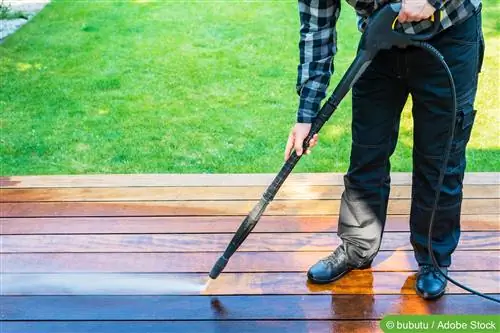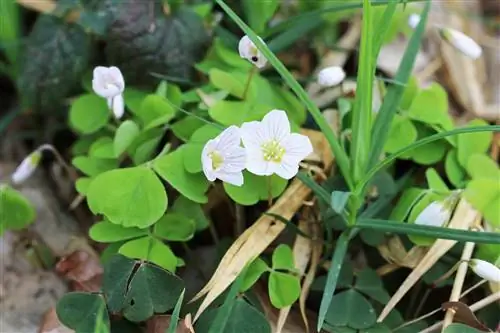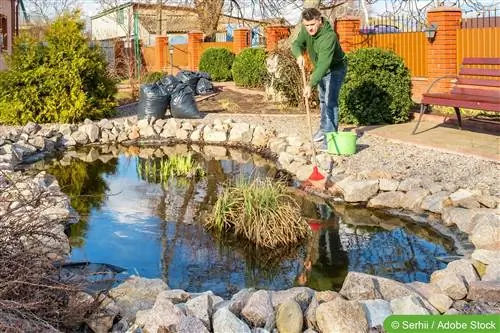- Author admin [email protected].
- Public 2023-12-17 03:39.
- Last modified 2025-06-01 06:48.
Once again, cleaning the wooden terrace is on the to-do list. Oak, Douglas fir, teak, larch or Bangkirai - different types of wood require different care and cleaning methods.
These types of wood are divided into different durability classes. Class 1 woods are considered very durable, while class 5 woods are considered less durable. Tropical woods such as teak or bangkirai are therefore particularly durable, robust and hard-wearing.
The increasingly popular Bangkirai wood, which is sometimes sold under the name “Balau” in specialist retailers because it comes from the Southeast Asian deciduous tree “Yellow Balau”, offers the best usage properties.
Wood coverings made from uncultivated oak and cultivated Douglas fir are considered to be moderately resilient. Fir and spruce woods are sensitive to this. Beech is not durable at all.
However, what all woods have in common is that, despite their good suitability for outdoor use, they always require a minimum of care and careful cleaning measures.
In order to effectively deal with the gray, unsightly legacy of the past, you need soapy water and clear water, a brush or a foam roller, a soft brush, a high-quality care oil and perhaps even a high-pressure cleaner.
Cleaning and care of the wooden terrace
Surface and wood structure determine the intensity of cleaning. The dirt sits particularly firmly in the grooves of the wooden floors. These can still be cleaned quite easily with a hard brush.
Afterwards, the entire terrace floor can be cleaned with soapy water. Finally, rinse with clear water.
If you want to clean robust, hard wood, you can also use a high-pressure cleaner. A really hard jet of water doesn't affect the highly resilient woods.
Expensive quality wood should not be treated so forcefully. Because these woods have a value-preserving protective layer, the high-pressure cleaner should not be used. It could attack this protective layer.
By the way, various professional construction equipment rental companies rent out suitable cleaning machines that make the work effective and noticeably easier.
Wind and weather are constantly affecting the wood on the terrace
Rain, snow, hail, sun, heat, cold, UV rays, even pests and rot - it is important to protect the area well from these harmful influences. Because even normal life on the terrace leaves signs of wear and tear, high-quality and reliable wood protection is necessary. It contains suitable moisture protection and at the same time prevents the wood from drying out excessively. Wood preservatives for the terrace also contain pigments that protect against fading of the color and against UV rays.
Greyed wood on the terrace needs careful treatment with a quality terrace oil. You choose a reputable product for the corresponding type of wood.
The terrace oil is best used on new wooden terraces for basic treatment and then further maintenance. This ensures that the terrace wood remains consistently resistant, protected from UV rays and maintained over the long term. The surfaces become smooth and water and dirt repellent.
How to use patio oil
Apply it to clean, dry and dust-free wood:
- Using the foam roller or a brush,
- Even application
- Dry time about 20 minutes
- Remove excess oil with a soft cotton cloth.
It is best to care for the wooden floor of the terrace once a year. Of course, a “spring cleaning” is a good idea for this.
The new wooden terrace
She needs basic care with oil. If you seal the wood with clear varnish, you will have retained the natural wood color. If the wood treated in this way darkens, this effect remains.
If you use high-pressure treated wood for the new terrace, you can paint it with a dark color because of the different shades and green areas. This coat ensures a uniform appearance and offers additional protection for the wood, which is already very resistant thanks to the pressure impregnation. It must be renewed regularly, ideally every two years.
New terraces made of raw wood are immediately treated with wood preservative.
The protection penetrates deeply and wraps itself around the wood fibers.
If you maintain your terrace regularly, clean it, care for it and protect it, you will constantly enjoy this favorite place. Then nothing stands in the way of relaxing, wonderful hours on your own well-kept terrace.
Reasons for a wooden terrace
Many people with their own terrace choose wooden flooring. Wood combines several positive properties, because on the one hand, wood always exudes a special harmony, so that you feel a little like you are on vacation on a wooden terrace.
On the other hand, wood naturally has particularly good properties for outdoor use.
In order to enjoy your wooden terrace for a very long time, it is also important to properly care and clean the wooden terrace.
How to properly clean a wooden terrace
The type of cleaning depends somewhat on the structure of the wooden planks. If the planks are grooved, cleaning them is a little more complicated. With a smooth wooden terrace, it is often enough to just remove the coarse dirt with a broom and then spray the terrace with a garden hose.
Since dirt can easily get stuck in the grooves of the wooden planks, it is important that they are cleaned particularly thoroughly. This is particularly important if the wooden terrace is then to be provided with a wood protective varnish or oil.
With a brush that is neither too hard nor too soft, you can easily remove sand and other dirt from the grooves. You can also use a high-pressure cleaner to clean the terrace.
However, if the wood is not of such high quality, damage can occur due to the high pressure of the water jet. This is particularly the case in the places where the individual wooden planks are connected to the substructure - i.e. everywhere where screws are fixed.
In addition, the protective layer can be removed by the high-pressure cleaner, so that appropriate wood protection must always be ensured after cleaning.
You can now rent special cleaning machines for patios in gardening stores, hardware stores or construction equipment rental companies. Of course, you can also buy such machines, which is a question of budget.
With such devices, the wooden terrace is cleaned particularly gently and thoroughly. The dirt is carefully removed with a special brush so that the surface is only minimally sanded.
This ensures that the original structure and color of the wooden planks are retained. However, even with this type of cleaning, appropriate wood protection must be ensured.
Proper care of a wooden terrace
Cleaning alone is not enough to maintain the country feel of a wooden terrace. In addition to thorough cleaning, it is also important to always ensure wood protection.
Which means are used in each individual case depends on which type of wood you have chosen. The different types of wood also have completely different requirements for a wood protection varnish or a wood protection oil.
When you thoroughly clean a wooden terrace using the measures described above, not only is the dirt removed, but also a bit of the previously used wood protection. If the wooden terrace has been cleaned with water, you should brush it again with a broom after it has dried and use sandpaper to sand any areas that may be very rough. This prevents the wood from becoming even more fibrous and causing you to get a splinter later when walking barefoot.
If the terrace is completely dry and the weather forecast says that it won't rain in the next few days, it's exactly the right time to apply a new wood protectant. You can buy appropriate wood preservatives in any well-stocked hardware store or gardening store, and you can also find many shops on the Internet that offer such products. You can also find what you are looking for in a specialist wood shop.
Another tip: the area between the substructure and the terrace itself should also be regularly cleared of leaves and other dirt. This prevents the terrace from rotting from below and becoming more susceptible to fungi and other pests.






